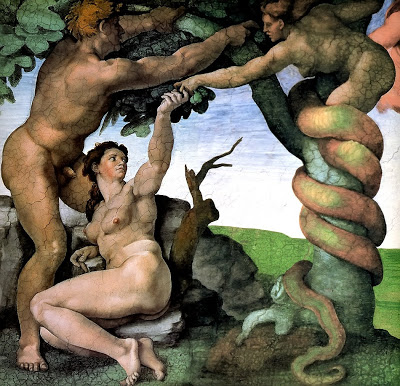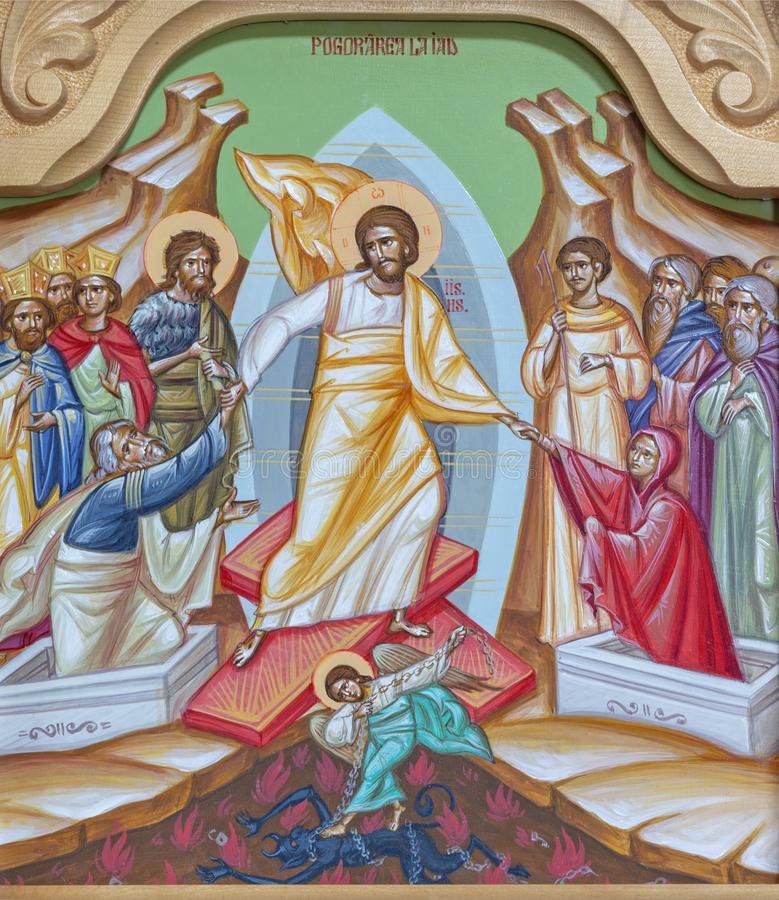But on the first day of the week, at early dawn, they came to the tomb, taking the spices that they had prepared. 2 They found the stone rolled away from the tomb, 3 but when they went in, they did not find the body. 4 While they were perplexed about this, suddenly two men in dazzling clothes stood beside them. 5 The women were terrified and bowed their faces to the ground, but the men said to them, “Why do you look for the living among the dead? He is not here, but has risen. 6 Remember how he told you, while he was still in Galilee, 7 that the Son of Man must be handed over to sinners, and be crucified, and on the third day rise again.” 8 Then they remembered his words, 9 and returning from the tomb, they told all this to the eleven and to all the rest. [Luke 24:1-9, NRSV]
[L] The youthful faces of Adam and Eve by on the ceiling of the Sistine Chapel, Vatican; [R] The aged faces of Adam and Eve in the iconography of Adam and Eve Raised from Hell.
At the culmination of the Easter Triduum, we found ourselves at the empty tomb. The Vigil took us from creation through Christ’s resurrection, complete with the new fire, bells and all those alleluias. There was vigour in our celebration. But on Easter morning, we feel kind of letdown as the lectionary readings strike a more somber mood and call the whole Church to take a step back and ask: What are the depth messages in all of this that we must as a Church integrate into our mission? The Church has set aside the next fifty days to deal seriously with that process.
The Orthodox icon of the Resurrection helps us in that process. The classical Byzantine icon shown above was painted by a sister of the monastery of Vallechiara.
Seeing such an icon for the first time may be a little confusing. At the surface level, the details usually show Jesus descending to the dead, taking Adam and Eve by the hand, surrounded sometimes by prophets and kings of the old covenant. These are puzzling because they seem so very different from the resurrection scenes we read in the Gospels (e.g., Luke 24:1—9) or even the accounts that St Paul recalls in 1 Corinthians. Are we not given images of the resurrection as “appearances” and “personal encounters” with the risen Christ experienced by a range of living people? But here in the icon, those Gospel accounts of mysterious and elusive encounters are replaced by a portrayal of the Risen Christ holding the hands of Adam and Eve. Now, Christ’s “noli me tangere” instruction to Mary Magdalene: “Do not hold me, for I have not ascended to the Father” (John 20:17) flies in the face of the physical hand-holding in the icon. What happened?
In the Orthodox tradition, classical icons serve to take viewers to the inner story, to the bedrock of the underlying story. Meditation on the icons thus takes us into another realm and another frame of reference. In The Dwelling of the Light: Praying with Icons of Christ, retired Anglican Archbishop Rowan Williams helpfully shares with us the reality that he has dived into.
The resurrection of Jesus Christ is the re-making of creation itself. Viewers see God and Adam and Eve, where it all began. Creation was vested with order and beauty. But things went bad due to human disobedience. Freely forgiving sinful humanity, God recreates through the suffering, death, and resurrection of Jesus Christ. He made all things new. Now, there is new life in Christ. This is where it begins again.
Just as God “in the beginning” created the universe out of nothing – darkness and void – God once again, recreates out of evil and darkness, but this time through the noble and beautiful life of Jesus. So this is not just a happy ending of the story of Jesus of Nazareth; it is the story of the Word of God speaking in the heart of darkness to bring life out of the void.
- Emerging from the darkness of his crucifixion (represented by the dark mandorla), the Risen Christ stands in the centre of the icon. The shattered gates of hell beneath his feet, he stands on a narrow bridge of rock spanning a dark pit where the defeated Satan resides.
- This is a picture of liberation. Christ’s white-clad figure comes out of the depth of divine life to bring the immediate presence of divine activity into the furthest depths of human experience.
Just as God “in the beginning” created human beings in His image and likeness, now God in the New Man accorded the fallen humanity with the possibility to imitate the New Man. They can refuse to be carriers of sin-contagion and avoid being death-bound. From the depth of desolation on Good Friday, we waited in darkness and desperation for liberation. Then, Easter happened and from desolation and desperation, we are given hope in full measure. This is what happens every time Easter is re-enacted, to commemorate afresh the suffering, death and resurrection of Jesus Christ in the life of the believing community. If you have been in the depth of human tragedy, pain, suffering, and despair, the icon assures you that Christ the liberator is at hand.
- But in this new beginning, Adam and Eve have grownold, the icon reminds us. Indeed, the aged faces of Adam and Eve are, for Rowan Williams, the most poignant feature of the icon. Those are wintry faces of Adam and Eve grown old, but in that moment of Christ’s resurrection, the icon offers a peek into something of how the spring begins in its heart. Gone of course are their radiant and naked youthful days of reckless living and mindless disobedience captured by Michelangelo on the ceiling of the Sistine Chapel. Scarred by life and by personal and social history, their faces are now lined by suffering and experience, their innocence long lost. There is no return. Now, what they display are the marks of guilt, for they have since gained the knowledge of good and evil, and the marks of hurts received and hurts done, for they carry with them the marks of history and of experience.
- Adam and Eve reflect each one of us and the burden we carry in us. Christ does not wave a magic wand to wipe out our history and our experience to return us to our first innocence. Christ reaching down to Adam and Eve grown old, is Christ reaching down to humanity with its joys and sorrows, successes and struggles, pain and failures. The resurrection is not about wiping out human history, our pain and our failure, henceforth giving us a clean slate. Rather, “it is about how pain and failure themselves – humanity marked by history – may yet be transfigured and made beautiful.” This is recreation wrought by Christ’s resurrection. This is renewal, in the sense of making all things new again.
Icons reinforce the understanding that what the Christian gospel offers is indeed a new beginning. It is a new beginning achieved by Jesus Christ who demonstrated that pain is part of the path of the authentic Christian journey as he moved from pain to hope, from darkness to light, and from death to life. At the same time, this itinerary witnesses to a transformation in which “real flesh and blood human beings with our histories” bear “the lines etched in our faces” by those personal and corporate seasons. Our histories are not discarded; rather, the God who created us has restored us.
- “The re-creation, the new beginning of resurrection is more wonderful because it is the planting of newness and freshness, beauty and vision and glory, in faces like yours and mine, in lives like yours and mine, in Adam and Eve as they are there depicted.”
That is what makes the resurrection good news for those who find themselves in the midst of pain and failure that have no solution in sight, or in a situation of seriously bad experience where there is no real hope. The resurrected Christ does not come with a magic wand to make all these negativities disappear. What the resurrected Christ does is to be present, to speak, and to transform. When that takes place in ordinary people who, with their ordinary, prosaic faces, have been recognized as saints, we will see “the glory and radiance coming through their very specific, recognizable contemporary faces.” They too, will have become our modern day resurrection icons. We shall know that:
- “It’s this flesh and blood, this history, these sufferings and these failures that the risen Jesus touches and transfigures… God begins always with who we are now and what we are now: and it’s there, now, that life comes from death, and light from darkness,” so that we may always begin anew “at every moment by the power and strength of the risen Jesus.”
May we learn to glorify him.
And may we wish you all a happy Easter!
Copyright © Dr. Jeffrey & Angie Goh, April 2022. All rights reserved.
You are most welcome to respond to this post. Email your comments to jeffangiegoh@gmail.com. You can also be dialogue partners in this Ephphatha Coffee-Corner Ministry by sending us questions for discussion.


